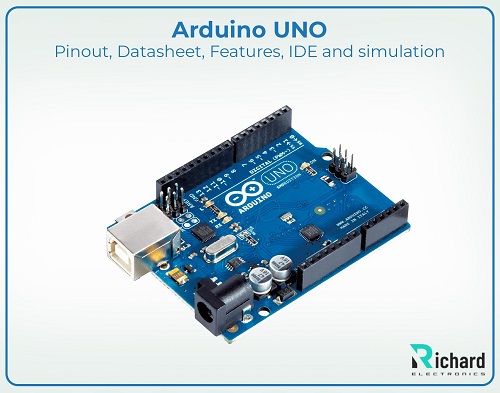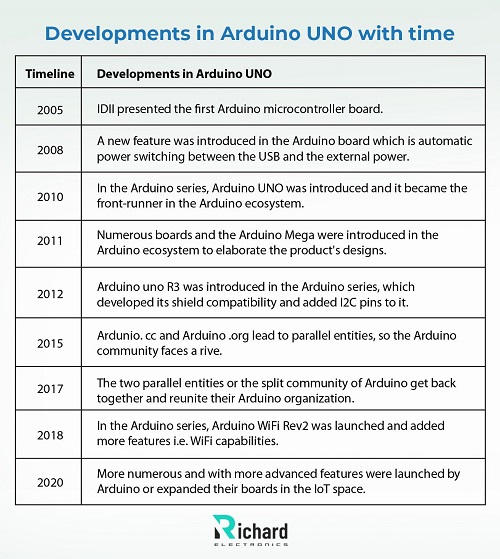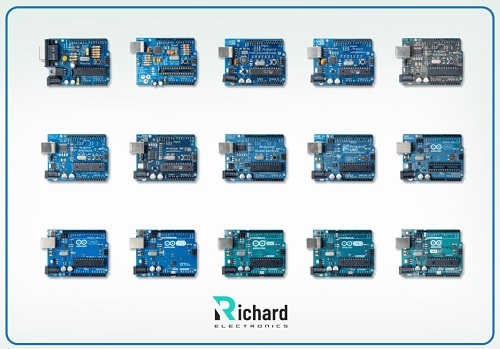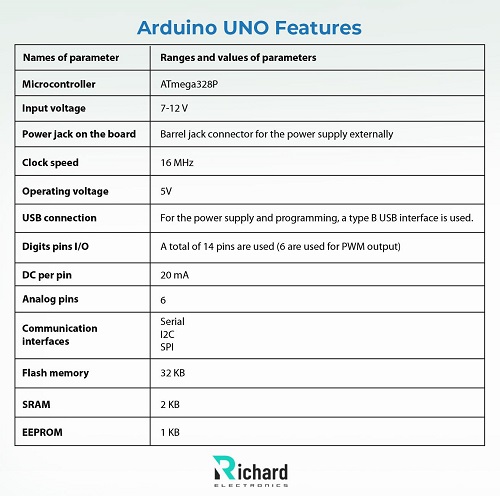Arduino UNO: Pinout, Datasheet, Features, IDE and simulation
Arduino UNO (A000066)is equipped with an Atmega328 microcontroller, a USB interface, 6 analog pins, and 14 digital pins. It supports three communication protocols: SPI, serial, and I2C. Let's dive into a detailed exploration of the Arduino UNO, covering its pinout, features, simulation, datasheet, and programming environment (IDE).

History of Arduino UNO:
The development of the Arduino Uno began in 2003 at the Interaction Design Institute Ivrea (IDI) in Italy. Professors and students recognized the need for an easy-to-use, affordable microcontroller board for creating embedded prototypes. In 2005, David Cuartielles, Tom Igoe, Massimo Banzi, and Gianluca Martino started working on designing a new microcontroller board named “Arduino.†The main goals were:
â—Â Plug and play board (driver installation required).
â—Â Easy to program.
â—Â Useful for both beginners and advanced users.
â—Â Affordable.
â—Â Compact design.
Developments in Arduino UNO over time:

|
Timeline |
    Developments in Arduino UNO |
|
2005 |
IDII introduced the first Arduino microcontroller board. |
|
2008 |
Automatic power switching between USB and external power was introduced. |
|
2010 |
Arduino UNO became the leading board in the Arduino ecosystem. |
|
2011 |
Numerous boards and the Arduino Mega were introduced to expand the product range. |
|
2012 |
Arduino UNO R3 was released, improving shield compatibility and adding I2C pins. |
|
2015 |
Arduino.cc and Arduino.org split, causing a community rift. |
|
2017 |
The two parallel entities reunited, restoring unity within the Arduino community. |
|
2018 |
Arduino WiFi Rev2 was launched, adding WiFi capabilities. |
|
2020 |
More advanced boards were launched, expanding the IoT offerings. |

Arduino UNO Features:
Arduino Uno is an open-source microcontroller board based on the ATmega328P, used for building various electronic projects. It is popular among engineering students, designers, hobbyists, and beginners due to its ease of use and versatility. With 14 digital pins, 6 analog inputs, and communication interfaces like serial, I2C, and SPI, it can be applied in robotics, sensor networks, IoT, and more. Key features include:

|
Names of parameter |
      Ranges and values of parameters |
|
Microcontroller |
ATmega328P |
|
Input voltage |
7-12 V |
|
Power jack on the board |
Barrel jack connector for external power supply |
|
Clock speed |
16 MHz |
|
Operating voltage |
5V |
|
USB connection |
Type B USB for power and programming |
|
Digits pins I/O |
14 total pins (6 for PWM output) |
|
DC per pin |
20 mA |
|
Analog pins |
6 |
|
Communication interfaces |
Serial I2C SPI |
|
Flash memory |
32 KB |
|
SRAM |
2 KB |
|
EEPROM |
Drilling Nozzles & Jet PipesIn the oil and gas drilling industry, efficiency and reliability are paramount. Our premium drilling nozzles and jet pipes are engineered to meet these demands, providing exceptional performance in challenging environments. Designed for optimal fluid dynamics, these Components ensure effective drilling operations by enhancing the flow of drilling fluids and maximizing the cooling and cleaning of the drill bit. Constructed from durable materials(tungsten carbide), our nozzles and jet pipes offer high wear resistance, ensuring long-lasting performance even under extreme conditions. With precision engineering and innovative designs, our products help reduce downtime and improve overall drilling efficiency, making them essential for any oil and gas operation. Jet Pipes,Nozzles,Drilling Nozzles,Carbide Bits Nozzles,Tungsten Carbide Nozzles,cemented carbide drill nozzle,carbide nozzle,nozzle,jet nozzle,carbide spray nozzle,Carbide nozzle for oil drilling Zigong MT Cemented Carbide Tech Co., Ltd. , https://www.mtcarbide.com |